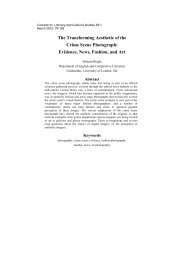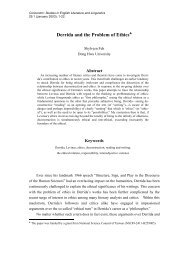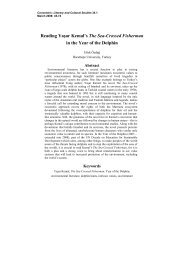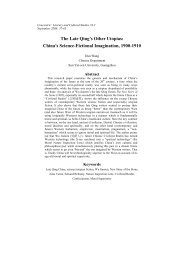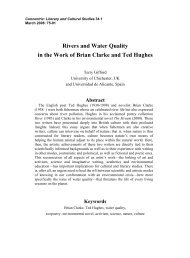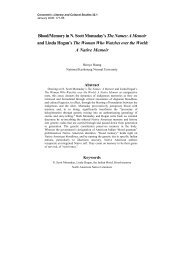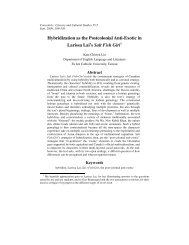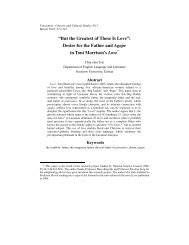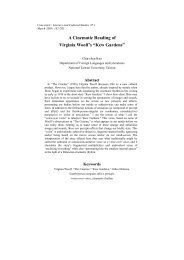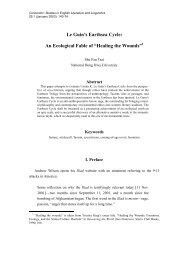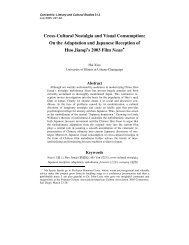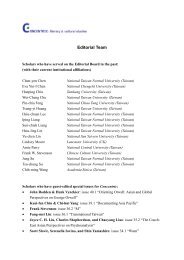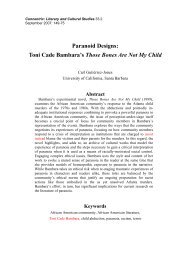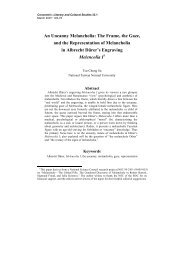Toward a Multicultural Gothic Aesthetics - Concentric
Toward a Multicultural Gothic Aesthetics - Concentric
Toward a Multicultural Gothic Aesthetics - Concentric
Create successful ePaper yourself
Turn your PDF publications into a flip-book with our unique Google optimized e-Paper software.
<strong>Concentric</strong>: Literary and Cultural Studies 33.1<br />
March 2007: 177-98<br />
Adorno, Foucault, and Said:<br />
<strong>Toward</strong> a <strong>Multicultural</strong> <strong>Gothic</strong> <strong>Aesthetics</strong> 1<br />
Andrew Hock Soon Ng<br />
Monash University<br />
Abstract<br />
This essay attempts to answer the question, albeit tentatively, “what is the<br />
<strong>Gothic</strong> aesthetics” and then to suggest how this aesthetics might serve as a<br />
critical apparatus for the reading and appreciation of narratives not usually<br />
associated with the genre. I first appropriate Adorno’s theory of ugliness to<br />
map out some initial coordinates of a <strong>Gothic</strong> aesthetics, and within this<br />
framework I look at the recurring <strong>Gothic</strong> themes of loss and transgression.<br />
Secondly, I re-examine the relations between psychoanalysis and the <strong>Gothic</strong>:<br />
deeming psychoanalysis vital to an understanding of <strong>Gothic</strong> aesthetics, I<br />
defend it from recent claims that it lacks historical specificity, in its<br />
“<strong>Gothic</strong>izing” approach to texts, by turning to Foucault’s “What is an<br />
Author” and Said’s Freud and the Non-European. Finally I endeavor to show<br />
how <strong>Gothic</strong> aesthetics, in its capacity to make clear on a foundational level<br />
how various kinds of transgression occur, can be a “multicultural” aesthetics,<br />
that is, can help us to elucidate not only Western literary texts but also Non-<br />
Western ones. This de-Westernizing (or de-colonializing) of <strong>Gothic</strong> aesthetics<br />
is indeed inevitable once we assume that it (perhaps like any aesthetics) must<br />
be prepared to face resistance from, and undergo transformation by, any of the<br />
narratives whose deep structures it attempts to illuminate. I also use Karatani<br />
Kojin’s notion of aesthetic “unbracketing” in support of my claim that the<br />
<strong>Gothic</strong> aesthetics may be multicultural.<br />
Keywords<br />
the <strong>Gothic</strong>, aesthetics, the ugly, Adorno, Foucault, Said,<br />
psychoanalysis, multiculturalism<br />
1 I would like to thank my two anonymous readers for their insightful comments and helpful<br />
suggestions. This essay is an extension of my meditation on the <strong>Gothic</strong> as a multicultural<br />
aesthetics, which was first conceived when writing the introduction to my book, Interrogating<br />
Interstices (forthcoming 2007).
178<br />
<strong>Concentric</strong> 33.1<br />
March 2007<br />
The <strong>Gothic</strong> as <strong>Aesthetics</strong> of Ugliness<br />
In the tradition of Plato and Kant, aesthetics (aesthesis means “perception” in<br />
Greek) has been concerned with our perception of “beauty” (and thus too of what is<br />
“not beautiful”). However, theorists like Berel Lang and Emory Elliot have<br />
observed that such a power to evaluate (or to “judge” to use Kant’s term)<br />
historically belongs to those “in a dominant position politically, legally, or<br />
economically over the other”; thus their aesthetic judgments may “demean and<br />
subordinate the other by pronouncing [a] person or his or her cultural production to<br />
be inferior, beneath consideration, or objectionable” (Elliot 3). <strong>Aesthetics</strong> in this<br />
formal, academic sense thus became “a tool of divisiveness, enmity and oppression”<br />
(3), presupposing universal standards of beauty and thus the ugliness (or more<br />
generally abnormality) of whatever does not meet these standards. Therefore in an<br />
era of cultural studies, multiculturalism, and glocalization, formal aesthetics has<br />
been considered highly suspect—at the very least, Eurocentric.<br />
A recent revival of aesthetics has thus shifted its focus away from the<br />
beautiful to “a specific kind of human experience” (Farber 2). An aesthetic<br />
experience, according to Alan Goldman, is fuelled by the object’s (whether manmade<br />
or “natural”) challenge to “our perceptual and emotional capacities. To meet<br />
these challenges simultaneously is to experience aesthetically” (Goldman 188).<br />
Therefore what is pre-defined by a given culture as “ugly,” “grotesque” or even<br />
“obscene” can still have aesthetic “value” (Zemach; not in the Works Cited).<br />
Indeed, for Theodor Adorno, beauty cannot be conceptualized without presupposing<br />
the ugly. For Adorno, the very fact that there are standards for what is art-worthy<br />
already suggests the “permanent return of the archaic [that is, the ugly], intertwined<br />
with the dialectic of enlightenment in which art participates” (Adorno 47). 2 In this<br />
rather Freudian configuration—the Unheimlich (uncanny) as “return of the<br />
repressed”—it seems ugliness is the original site of aesthetics, yet one which must<br />
2 Adorno is not the first theorist to see the mutual dependence of beauty and ugliness. The<br />
concept of the sublime in Burke and Kant (to whom Adorno of course refers) addresses the notion<br />
that the beautiful and terrible are dialectically intertwined, and that the former is always tinged<br />
with a threatening proportion of the latter. The interdependence between beauty and ugliness in<br />
aesthetics is not an unfamiliar one in Eastern philosophy. For example, the Tao Té Ching (around<br />
600BC) records that the dialectical relationships between binary opposites constitute “the Way”.<br />
Specifically regarding beauty and ugliness, it is written that “Since the world points up to beauty<br />
as such / There is ugliness too. / If goodness is taken as goodness / Wickedness enters as well”<br />
(Lao Tzu 54).
Ng<br />
Adorno, Foucault, and Said<br />
179<br />
be subsequently repressed by a rationalizing (“conscious”) Enlightenment thinking<br />
in order for the fantasy or “spell” of the beautiful to unfold:<br />
Beauty is not the Platonically pure beginning but rather something<br />
that originated in the renunciation of what was once feared, which<br />
only as a result of this renunciation—retrospectively, so to speak,<br />
according to its own telos—became the ugly. Beauty is the spell over<br />
the spell, which devolves upon it. The ambiguousness of the ugly<br />
results from the fact that the subject subsumes under the abstract and<br />
the formal category of ugliness everything condemned by art:<br />
polymorphous sexuality as well as the violently mutilated and lethal.<br />
(47) 3<br />
Beauty in Adorno’s view, then, is modern art’s struggle for independence<br />
from pre-Enlightenment aesthetics. The modern emphasis on rationality and<br />
empirical certainty dictates that art, for it to have any worth, must disavow the<br />
ambiguity and inchoateness of anything which cannot be explained and classified in<br />
order to qualify as “art.” Anything that suggests the shapeless and the anomalous is<br />
immediately relegated to the ugly, and placed outside the domain of modern<br />
aesthetics. But as Adorno argues, the ugly can never finally be eschewed: it remains<br />
the unacknowledged “site” of aesthetics, awaiting its moment of return. In this<br />
formulation then, an aesthetic experience is not one from which pleasure is derived<br />
but one which unnerves and disorients. As a reflection of ugliness, art, Adorno<br />
argues, “could not disavow remembrance of accumulated horror; otherwise its form<br />
would be trivial” (Adorno 324).<br />
3 Despite Adorno’s comment that the “psychoanalytical theory of art is superior to idealist<br />
aesthetics in that it brings to light what is internal to art and is not itself artistic”(Adorno 8-9), he<br />
is critical of Freud’s stance on art. “For Freud”, argues Adorno, “artworks are not immediate wish<br />
fulfillments but transform unsatisfied libido into a socially productive achievement, whereby the<br />
social value of art is simply assumed, with uncritical respect for art’s public reputation” (10).<br />
Such a view deprives artworks, according to Adorno,<br />
of their antithetic stance to the not-I, which remains unchallenged by the<br />
thorniness of artworks. They are exhausted in the psychical performance of<br />
gaining mastery over instinctual renunciation and, ultimately, in the achievement<br />
of conformity. . . . The conformist psychoanalytical endorsement of the<br />
prevailing view of the artwork as a well-meaning cultural commodity<br />
corresponds to an aesthetic hedonism that banishes art’s negativity to the<br />
instinctual conflicts of its genesis and suppresses any negativity in the finished<br />
work. (12)
180<br />
<strong>Concentric</strong> 33.1<br />
March 2007<br />
But Adorno’s aesthetic theory goes beyond the mere proposition that beauty<br />
is always haunted by some ancient ugliness that is ever threatening to “return.” This<br />
tension between the beautiful and the ugly is what, for Adorno, precipitates or<br />
“explodes into” (84) art itself:<br />
Even this volatilization of aesthetic transcendence becomes aesthetic,<br />
a measure of the degree to which artworks are mythically bound up<br />
with their antithesis. In the incineration of appearance, artworks break<br />
away in a glare from the empirical world and become the counterfigure<br />
of what lives there; art today is scarcely conceivable except as<br />
a form of reaction that anticipates the apocalypse. Closely observed,<br />
even tranquil works discharge not so much the pent-up emotions of<br />
their makers as their works’ own inwardly antagonistic forces. (85)<br />
Thus the “return” of the ugly is rather the force of the archaic as it disturbs the<br />
surface stability of the beautiful than the artist’s mimetic impulse to free his/her<br />
work from the tyranny of established aesthetic standards. <strong>Aesthetics</strong> for Adorno is<br />
an engagement with antithesis, deliberately breaking away from empirical reality to<br />
delve into the unspeakable space of the unconscious where perversion, violence,<br />
and of course ugliness preside; it entails our experience of the critical tension that a<br />
particular artwork represents. Artworks must “[strain] towards a synthesis<br />
develop[ed] in the form of their irreconcilability” (234). In psychoanalytical<br />
parlance the perceiving subject, by apprehending this tension, is able to break<br />
through the spell of “reality” to confront what transpires, horribly, beneath its<br />
veneer<br />
Adorno’s concept reminds us that the <strong>Gothic</strong> is in the first place a powerful<br />
perceptual or aesthetic experience. Like the mimetic discharge of which Adorno<br />
speaks, the <strong>Gothic</strong> can be construed as a violent defiance of the ideals of Romantic<br />
literature, forcing the latter to face its own “dark side.” Indeed, as Michael Gamer<br />
observes, Romantic writers were very often <strong>Gothic</strong>ists themselves (Coleridge and<br />
Byron, for example) or at least tended to pick up “the conventions and practices of<br />
their <strong>Gothic</strong> contemporaries,” a fact which “exemplifies something more fundamental<br />
about Romantic aesthetic practice itself” (Gamer 102). The very qualities<br />
which Romantic ideology ostentatiously rejects return through its cracks to haunt<br />
the pages of Romantic writings before becoming a “low-brow” offshoot, one which<br />
in time became even more popular and marketable than its “host.” But more than<br />
just a parasitical double of Romantic aesthetics that takes on its own independent
Ng<br />
Adorno, Foucault, and Said<br />
181<br />
life, <strong>Gothic</strong> aesthetics invites a critical tension in the act of apprehending an artwork<br />
(in this case literary work): signifiers now proliferate into monstrous proportions<br />
and interpretations become ambivalent. As an aesthetic enterprise, then, the <strong>Gothic</strong>,<br />
I would argue, can be both a type of writing and a way of reading, one that is<br />
particularly useful in responding to “ugliness” in its broadest sense (which includes<br />
the experiences of trauma, horror, and death). In this sense <strong>Gothic</strong> literature cannot<br />
really be separated from <strong>Gothic</strong> criticism: together they outline the project of<br />
<strong>Gothic</strong> aesthetics. The critical, extra-literary sense of the <strong>Gothic</strong> vitally depends on<br />
the <strong>Gothic</strong> text’s literariness.<br />
Various critics have noted that <strong>Gothic</strong> literature evokes anxiety in the reader<br />
because it disrupts his or her familiarity with her world. Coral Ann Howells, for<br />
example, argues that “instead of a sense of stability and harmony, what we find in<br />
<strong>Gothic</strong> fiction is a dreadful insecurity in the face of a contingent world which is<br />
entirely unpredictable and menacing” (Howells 5). There is an affinity here with<br />
Adorno’s theory since <strong>Gothic</strong> aesthetics, like ugliness, is precisely the tension<br />
invoked by a failure to negotiate with an otherness that persistently threatens<br />
familiarity. 4 What especially marks the <strong>Gothic</strong> nature of a particular narrative is the<br />
accumulation of this threat as the narrative progresses, intensifying rather than<br />
muting its element of horror:<br />
Rather than canceling the significance of the original event by<br />
displacing it, the horror story increases that event’s significance,<br />
multiplying its effect with each repetition. It articulates a paradox of<br />
reversibility and irreversibility in the given social shape of death. For<br />
while death is irreversible in the nonfictive world, in the horror story<br />
it may threaten an infinity of reversibility; it becomes the finale<br />
which is not final, whose limits are determined by its narrative<br />
possibilities. (Stewart 36)<br />
Both critics emphasize that the <strong>Gothic</strong>-aesthetic “effect” on the reader is<br />
derived from the narrative itself. The sense of ontological disorientation and the<br />
4 Chris Baldick and Robert Mighall view the horror of the <strong>Gothic</strong> as lying in its “emphasis on<br />
anachronism . . . the threat derives from <strong>Gothic</strong> vestiges which survive into the present and<br />
threaten the values of modernity” (224). This reading need not (though it could) be taken to<br />
circumscribe the <strong>Gothic</strong> within a particular historical period: perhaps these “vestiges” are more<br />
suggestive of a prehistorical or ahistorical (trans-temporal), primitive or barbarian force that<br />
might even recall Adorno’s reflections on the aesthetic tension and explosion.
182<br />
<strong>Concentric</strong> 33.1<br />
March 2007<br />
infinite deferral of actual death are experiences that are not just thematically but<br />
narratologically grounded.<br />
I want to further illuminate Adorno’s notion of aesthetic tension by focusing<br />
on two closely-related elements of <strong>Gothic</strong> writing, loss and transgression. The<br />
return of the repressed (whether historical or psychical) already insinuates the<br />
unremitting presence of loss, as well as a boundary violation effected by a<br />
recurrence of something which should not recur. <strong>Gothic</strong> aesthetics is the aesthetics<br />
of loss and/or transgression not just as “theme” but as actual (life and/or narrative)<br />
experience. “<strong>Gothic</strong> aesthetics is located at the interstices between the “subject’s<br />
<strong>Gothic</strong> spirit [and] its <strong>Gothic</strong> flesh in a way that privileges neither” (Bruhm 2).<br />
Bruhm specifically traces this tension between, on the one hand, a “proliferation of<br />
language that borders on obsession-compulsion” (page ) and attempts to make<br />
visible what is otherwise “hidden, buried, or lost from view,” and on the other the<br />
slipperiness of “otherness” that confounds language: “such legibility only increases<br />
the horror within each novel, as it points even more forcefully to the presence of the<br />
supernatural, that which can never be captured in language” (2). 5 For in <strong>Gothic</strong><br />
narratives:<br />
loss is a kind of revenance in that the very recognition of loss (or<br />
even, some might say, the unconscious experience of loss) is itself an<br />
exercise of language or image-making. However, the image or the<br />
word which is produced by loss and desire also generates loss and<br />
desire in that the word is never fully able to complete the subject’s<br />
dismembered body [or ruptured psyche, I may add] or to lay his/her<br />
ghosts to rest. The <strong>Gothic</strong> subject is always a “subject in excess,”<br />
desiring more than the signifying systems [especially language] can<br />
provide.” (Bruhm 3)<br />
If as Adorno says the aesthetic quality of an artwork is precisely its own<br />
contradictions, then one of these contradictions may be this split in the <strong>Gothic</strong><br />
“subject”—whether taken as author, character and/or reader. In a sense here we are<br />
taking the text itself as a “body”; if in a <strong>Gothic</strong> narrative author’s/narrator’s/<br />
character’s/reader’s “flesh” cannot “sublimely transcend” (Bruhm 3) its corpore-<br />
5 The problem with this reading, however, is that Bruhm seems to neglect the fact that many<br />
<strong>Gothic</strong> narratives are actually short stories (Bruhm’s essay heavily privileges the great <strong>Gothic</strong><br />
novels), and that many contemporary <strong>Gothic</strong> novels are linguistically rather minimalist (for<br />
example, the narratives of Chuck Palahniuk).
Ng<br />
Adorno, Foucault, and Said<br />
183<br />
ality to attain the spiritual, then this is true of the body of the text. And here<br />
“spiritual” also means being at one with (“in spirit with”) a particular ideology or<br />
community which the “<strong>Gothic</strong> flesh” desires but fails to realize. This failure may<br />
result in a violent retaliation by the body against the spirit which renders the body<br />
“abject” or “monstrous.” If then the narrative text itself is likened to a body, the<br />
proliferation of linguistic markers signals its inability to articulate the unspeakable,<br />
finally rendering the whole narrative “monstrous.” The endeavor to “mean” leaves<br />
the text ultimately meaningless.<br />
The <strong>Gothic</strong> quality of a narrative, then, is not derived from specific episodes<br />
of trauma or horror but rather a lingering presence of loss which refuses to dissolve,<br />
and of which both trauma and horror are effects. The inability of the subject to deal<br />
with this loss threatens her sense of coherence and directly relegates her to a liminal<br />
space of being. The subject is then left with two alternatives: to embody the liminal<br />
and risk becoming a “monster” or to dissolve the self (as in death) as a mode of<br />
resignation or renunciation (Frankenstein’s creature at the novel’s end) or strategy<br />
of resistance (Dr. Jekyll). This liminality (marginality, in-betweenness) already<br />
presupposes that transgression is at work. Whether deliberately or as the result of<br />
circumstances, the <strong>Gothic</strong> subject’s experience of loss involves an inevitable act of<br />
“crossing over” into a heterotopic, unheimlich space—one that is at once familiar<br />
and unfamiliar, real and unreal. The heterotopia, according to Foucault, is a<br />
“placeless place” which, like a mirror,<br />
exerts a sort of counteraction on the position that I occupy. . . . [The<br />
mirror] makes this place that I occupy at the moment when I look at<br />
myself in the glass at once absolutely real, connected with all the<br />
space that surrounds it, and absolutely unreal, since in order to be<br />
perceived it has to pass through this virtual point which is over there.<br />
(“Of Other Spaces” 24)<br />
This has a direct relation to <strong>Gothic</strong> aesthetics. As Fred Botting puts it, the “mirror of<br />
fiction . . . [not only] transports readers into remote and unreal places, but it is read<br />
in a specific place in the present, thereby disturbing a sense of reality along with the<br />
aesthetic values supposed to sustain it” (“In <strong>Gothic</strong> Darkly” 9). Once again, this<br />
argument recalls Adorno’s notion of tension. As noted earlier, the aesthetics of<br />
beauty cannot be divorced from ugliness—the former is, in fact, premised on the<br />
latter—in the same way that “realist” fiction and its attending aesthetic values<br />
cannot be separated from its <strong>Gothic</strong> countersite and (anti-) aesthetics.
184<br />
<strong>Concentric</strong> 33.1<br />
March 2007<br />
It is in this sense that <strong>Gothic</strong> writing is transgressive, not in the sense of<br />
“challenging” or “resisting” but more in the sense of stretching reality to its limits,<br />
and from there fissuring reality with its own limitations. As Foucault argues in his<br />
“Preface to Transgression”:<br />
Transgression is an action that involves the limit, that narrow zone of<br />
a line where it displays the flash of its passage, but perhaps also its<br />
entire trajectory, even its origin; it is likely that transgression has its<br />
entire space in the line it crosses. The play of limits and transgression<br />
seems to be regulated by a simple obstinacy: transgression<br />
incessantly crosses and recrosses a line that closes up behind it in a<br />
wave of extremely short duration, and thus it is made to return once<br />
more right to the horizon of the uncrossable. But this play is<br />
considerably more complex: these elements are situated in an<br />
uncertain context, in certainties that are immediately upset so that<br />
thought is ineffectual as soon as it attempts to seize them. (73)<br />
Although I am decontextualising Foucault’s point here, his view that<br />
transgression is a form of persistent recurrence (a repeated crossing-and-recrossing<br />
of the line, a play of limits at/on the line) suggests the obsessive-compulsive mode<br />
that Bruhm observes in <strong>Gothic</strong> narratives, and is useful for my formulation of<br />
<strong>Gothic</strong> aesthetics. 6 The <strong>Gothic</strong> novel proliferates linguistically in its attempt to utter<br />
(or cross over to) the unspeakable, but always in différance, because the unspeakable<br />
cannot ultimately be apprehended—thus necessitating a return to “the horizon<br />
of the uncrossable.” Transgression presupposes an attempt to breach the limit while<br />
ultimately failing to do so: the subject arrives at the limit, momentarily violates it,<br />
and then becomes reabsorbed within the limit; this results in her being trapped on<br />
the threshold of that very limit. In this sense then, the counter-action of the <strong>Gothic</strong><br />
is not so much resistive as it is transgressive. 7 It brings to the fore certain psychological,<br />
social and/or cultural constraints and the ways in which subjects negotiate<br />
with and transgress them, often harrowingly.<br />
6 Foucault is mainly discussing the mutual dependence of transgression and the limit, which has<br />
arguably become the normal state of affairs since the Nietzschean declaration that “God is dead.”<br />
7 After all, many traditional and modern <strong>Gothic</strong> narratives may seem “revolutionary” in their<br />
challenge of the status quo, but in the end they are, as Baldick and Mighall have noted, rather<br />
conservative in their approach and especially in the way they resolve difficult issues (Baldick and<br />
Mighall 212). See also Botting’s essay, “The <strong>Gothic</strong> Production of Unconsciousness” (28-31).
Ng<br />
Adorno, Foucault, and Said<br />
185<br />
Foucault further notes that transgression de-stabilizes notions of certainty by<br />
revealing the irreconcilability between the subject apprehending and the object<br />
apprehended. What results from such a tension is the breakdown of the former’s<br />
psyche to expose a fundamental void residing within the “I.” The inability to<br />
surmount the object apprehended ruptures the certainty of the self, rendering it<br />
“ineffectual.” Reading this view against Adorno’s aesthetic theory, we note an<br />
interesting correlation between the two theorists with regard to art and how it<br />
should work aesthetically. For although Adorno does not use the term “transgression”<br />
in his argument, what he has to say about aesthetic tension, and the<br />
straining toward a “synthesis of irreconcilability,” certainly echoes Foucault’s point.<br />
From the above discussion we see that transgression and loss are closely related,<br />
and that <strong>Gothic</strong> aesthetics (at least when we approach it via Adorno and Bruhm) lies<br />
between or encompasses the two. A subject transgresses because she is confronted<br />
with, and attempts to apprehend, an object; but she fundamentally cannot do so, and<br />
the result is a collapse of her sense of being-in-the-world. Unsurprisingly, for the<br />
subject it is death, or madness, or trauma which ensues.<br />
Psychoanalysis and the <strong>Gothic</strong><br />
What I am calling the <strong>Gothic</strong> aesthetics has much to do with the critical<br />
apparatus that has gone into shaping its discourse. Traditional <strong>Gothic</strong> literature<br />
would not have experienced resurgence today if it were not for the collective<br />
theories that have given it a new lease on life. The return of the <strong>Gothic</strong> repressed is<br />
occasioned by a reinvestigation of the issues raised by contemporary theoretical<br />
perspectives. And certainly these issues and these theories are also instrumental in<br />
motivating a new generation of writers to deploy the <strong>Gothic</strong> in their work, as<br />
evidenced in the writings of Angela Carter and Salman Rushdie. Of the various<br />
theories, it is psychoanalysis (tampered variously by feminism, postmodernism, and<br />
more recently postcolonialism) that has had the most profound influence on<br />
contemporary <strong>Gothic</strong> criticism. And yet, as much as psychoanalysis has helped to<br />
rejuvenate <strong>Gothic</strong> studies, it is also itself a kind of “<strong>Gothic</strong> discourse.” In other<br />
words psychoanalysis, despite foregrounding itself as a scientific (psychological)<br />
enquiry into the unconscious, is in the final analysis an aesthetics (or more precisely,<br />
an anti-aesthetics). Terry Eagleton claims that “it is perhaps more accurate to<br />
characterize Freud as a thinker who, while inheriting something of the great tide of<br />
aestheticizing thought which we have followed through the nineteenth-century,<br />
receives this legacy in a deeply pessimistic spirit, as a heritage gone sour” (268).
186<br />
<strong>Concentric</strong> 33.1<br />
March 2007<br />
Psychoanalysis disturbs the confidence that traditional aesthetics can represent<br />
mankind’s “unity of spirit and sense, reason and spontaneity” (Engleton 265), and<br />
instead reveals the self to be fissured by unspeakable desires. At such, it borrows<br />
the readily available vocabulary of the <strong>Gothic</strong> to articulate its inquiry into the<br />
uncharted territories of the human mind and body. For like the <strong>Gothic</strong>,<br />
psychoanalysis is a discourse of loss and transgression, “[telling] us that the free<br />
individual is in fact caught up in an over-determined chain of relations; moreover,<br />
the temptation to remain or return to previous stages impedes individual change.<br />
Rather than being a tool for explaining the gothic, then, psychoanalysis is a late<br />
gothic story which has emerged to help explain a twentieth-century experience of<br />
paradoxical detachment from and fear of others and the past” (Kilgour 220; see also<br />
Castle 237).<br />
Thus to argue, like Baldick and Mighall, that the emphasis on a psychological<br />
model in recent <strong>Gothic</strong> criticism is misguided certainly suggests a limited view of<br />
<strong>Gothic</strong> narratives (or any literature, for that matter). Baldick and Mighall’s primary<br />
concern is that contemporary <strong>Gothic</strong> criticisms tend to obfuscate <strong>Gothic</strong> writings’<br />
historical trajectory by over-emphasizing their psychological significance. 8 I agree<br />
that much psychoanalytically-inflected <strong>Gothic</strong> criticism tends to ignore a work’s<br />
historicity as a potential site for theoretical analysis. Yet to argue that “<strong>Gothic</strong><br />
Criticism is condemned to repeat what it has failed to understand and so reproduces<br />
in its own discourse what we call the trope of ‘<strong>Gothic</strong>ising’ the past, typically<br />
casting the nineteenth-century bourgeoisie in the melodramatic light reserved for<br />
the Italian aristocracy or the Spanish Inquisition by Radcliffe and Lewis” (Baldick<br />
and Mighall 210) is certainly a myopic way of approaching literature; for this is<br />
tantamount to saying that the <strong>Gothic</strong> novels must always be read against their<br />
historical moments, which suggests that these works cannot signify beyond those<br />
moments. This, according to the two critics, is what current <strong>Gothic</strong> criticism has<br />
failed to understand; they accuse <strong>Gothic</strong> criticism of “falsifying” (“<strong>Gothic</strong>ising”)<br />
the texts’ histories, and directly making the narratives serve the critic’s analytical<br />
ends rather than allowing them to demonstrate their “true” historical affinities.<br />
However, in my view, Baldick and Mighall’s historical approach fails to consider<br />
8 In my view the main shortcoming in Mighall and Baldick’s thesis is that, again, they limit their<br />
discussion to a very narrow selection of canonical <strong>Gothic</strong> works. Also, they seem to have missed<br />
the point that Freud’s work often draws on history. To cite one example, in his The Interpretation<br />
of Dreams, Freud notes that his argument has a foundation in the “prehistoric view of dreams”,<br />
especially in “classical antiquity” (36). He then goes on to discuss, among others, Aristotle’s<br />
understanding of dreams (36-39). Psychoanalysis as theory often considers the historical context<br />
of ideas; as practice it looks for the influence of the past and of memories.
Ng<br />
Adorno, Foucault, and Said<br />
187<br />
the reciprocal relationship between the <strong>Gothic</strong> and psychoanalysis, and restricts the<br />
number of interpretative possibilities. After all, is not the yardstick of good<br />
literature its ability to invite innovative interpretations that go beyond its authorial<br />
and historical boundaries To adhere to these two critics’ viewpoint is to say that<br />
<strong>Gothic</strong> novels have nothing new to tell us beyond what they reveal at and of their<br />
own historical moments. Another problem with this kind of argument is that it does<br />
not tell us why and how <strong>Gothic</strong> (or for that matter any) literature can invite certain<br />
emotional responses from the reader. Baldick and Mighall’s injunction, useful as a<br />
reminder that literature must always be carefully contextualized, falters when it<br />
comes to treating a literary work as an aesthetic representation.<br />
For Foucault, critical theories, when applied to texts, enable “an endless<br />
possibility of discourse” (“What Is an Author” 114). Thus Freud and Marx (whom<br />
Foucault calls the “founders of discursivity” [114]) are very different from the 19 th -<br />
century literary authors in that their works produce “the possibilities and the rules<br />
for the formation of other texts” (114). At one point in “What is an Author”<br />
Foucault writes:<br />
The founders of discursivity (I use Marx and Freud as examples,<br />
because I believe them to be both the first and the most important<br />
cases) make possible something altogether different from what a<br />
novelist makes possible. Ann Radcliffe’s texts opened the way for a<br />
certain number of resemblances and analogies which have their<br />
model or principle in her work. The latter contains characteristic<br />
signs, figures, relationships, and structures which could be reused by<br />
others. In other words, to say that Ann Radcliffe founded the <strong>Gothic</strong><br />
horror novel means that in the nineteenth-century <strong>Gothic</strong> novel one<br />
will find, as in Ann Radcliffe’s works, the theme of the heroine<br />
caught in the trap of her own innocence, the hidden castle, the<br />
character of the black, cursed hero devoted to making the world<br />
expiate the evil done to him, and all the rest of it.<br />
On the other hand, when I speak of Marx and Freud as founders of<br />
discursivity, I mean that they made possible not only a certain<br />
number of analogies, but also (and equally important) a certain<br />
number of differences. They have created a possibility for something<br />
other than their discourse, yet something belonging to what they<br />
founded. (114)
188<br />
<strong>Concentric</strong> 33.1<br />
March 2007<br />
Although Foucault does not attempt to draw a relationship between<br />
psychoanalysis (and Marxism) and the <strong>Gothic</strong>, it is surely a tacit understanding of<br />
their association which leads him to compare Freud and Marx with Ann Radcliffe. 9<br />
When a literary text, for instance a <strong>Gothic</strong> novel, is read against a theoretical<br />
discourse (or against several of them), what results is the dual performance of what<br />
we might call “literary aesthetics” and “critical aesthetics.” The former is what<br />
Foucault attributes to Radcliffe: what makes a <strong>Gothic</strong> novel “<strong>Gothic</strong>” are certain<br />
characteristics, analogies, models, paradigms that are shared with other <strong>Gothic</strong><br />
works. This usually occurs on a thematic or imagistic level (such as the barren<br />
landscape, the old mansion/castle), but resemblances in deep structures are also<br />
useful points of reference. These deep structures, however, can only emerge<br />
through the deployment of a critical apparatus such as psychoanalysis, Marxism,<br />
and/or poststructuralism. Thus, taking into account Kilgour and Castle’s claims that<br />
Freudianism is itself a kind of “<strong>Gothic</strong> story,” we could argue that <strong>Gothic</strong> narratives<br />
and psychoanalytic readings of them share a dialectical relationship, each fostering<br />
the other’s “aesthetic” force.<br />
Having established the aesthetical dimension of psychoanalysis, I want to now<br />
address its efficacy as a theoretical framework for reading non-Western narratives.<br />
Insofar as psychoanalysis is a Western-centric “aesthetic” story-theory, its application<br />
to non-Western narratives remains problematic because of a potential<br />
predilection toward literary-theoretical “colonialism.” Foucault’s view provides a<br />
tentative resolution to this dilemma: as important as it is to elicit the deep structures<br />
of desires inherent in non-Western literatures when “psychoanalyzing them,” it is<br />
equally important to pay attention to the way in which psychoanalytical principles<br />
are reshaped by these literatures. This is (at least partly) what I take Foucault to<br />
mean by the “otherness” that is inherent in any discursive enterprise. Within such a<br />
framework, psychoanalysis is no longer used prescriptively but rather reflexively,<br />
becoming transformed by the very object which it seeks to illuminate. Such a view<br />
is in line with Edward Said’s assessment of the endurance of Freud:<br />
Freud is a remarkable instance of a thinker for whom scientific work<br />
was, as he often said, a kind of archaeological excavation of the<br />
buried, forgotten, repressed and denied past . . . . Freud was an<br />
explorer of the mind, of course, but also, in the philosophical sense,<br />
an overturner and a re-mapper of accepted or settled geographies and<br />
9 The classic Marxist reading of <strong>Gothic</strong> writings is now surely Franco Moretti’s essay,<br />
“Dialectic of Fear,” in his Signs Taken for Wonders.
Ng<br />
Adorno, Foucault, and Said<br />
189<br />
genealogies. He thus lends himself especially to rereading in different<br />
contexts, since his work is all about how life history offers itself by<br />
recollection, research and reflection to endless structuring and<br />
restructuring, in both the individual and the collective sense. That we,<br />
different readers from different periods of history, with different<br />
cultural backgrounds, should continue to do this in our readings of<br />
Freud strikes me as nothing less than a vindication of his work’s<br />
power to instigate new thought, as well as to illuminate situations that<br />
he himself might never have dreamed of. (Said 27)<br />
For Said, then, Freud’s theories transcend temporal, cultural and geographic<br />
boundaries precisely because they are malleable enough to accommodate the<br />
“otherness” of the “other” even as they shed light on the way this “other” functions.<br />
In illuminating the <strong>Gothic</strong>ity of non-Western writings, a psychoanalytical reading<br />
does not reject their cultural underpinnings but rather carefully negotiates them.<br />
This strategy might perhaps satisfy Baldick and Mighall’s “historical” predilections,<br />
as well as allowing extra-literary paradigms to operate.<br />
Speaking of criticism in general, and <strong>Gothic</strong> criticism in particular, David<br />
Punter writes that “there would be no possibility for criticism to isolate a single text,<br />
a non-duplicitous textual act; instead criticism would only be able to realize itself<br />
by entering into the ‘hall of absence’, the clinic for chronic originary doubt. Like a<br />
ghost tied to, and doomed to return to, an already inscribed location, criticism itself<br />
would be doomed to haunt a site which can never be fully recaptured” (“Spectral<br />
Criticism” 261). Here Punter is discussing the proliferation of what he terms<br />
“spectral criticism” which, in his view, seems to characterize much recent<br />
theoretical work dealing not just with literature but with cultural studies as well.<br />
Interpretation, in the final analysis, occurs “only within an encircling horizon of<br />
mistranslation, of uninterpretability” (264). The tension (Punter uses the term<br />
“dialogue” [264]) between the subject and object of interpretation results in what I<br />
am calling “critical aesthetics”—which in the end cannot be divorced from an<br />
artwork’s inherent aesthestic worth. And it is in <strong>Gothic</strong> criticism that the spectralization<br />
of interpretation is most profoundly realized. Because of the <strong>Gothic</strong> concern<br />
with various forms of repression, the unspeakable (ranging from supernaturalism to<br />
psychological fissures), and abjection, to discuss it is always to do so in tremulous<br />
abeyance; to interpret its concerns necessarily “ghosts” them, revealing the fact of<br />
their signifier’s (or signifiers’) irretrievability in the very act of enunciation.
190<br />
<strong>Concentric</strong> 33.1<br />
March 2007<br />
Interpreting <strong>Gothic</strong> narratives is always a paradoxical act, at once a criticism in<br />
excess and a reading of loss.<br />
That psychoanalysis has played such an important role in <strong>Gothic</strong> criticism is<br />
precisely because of their uncanny association. Like the <strong>Gothic</strong>, psychoanalysis is a<br />
discourse which always implies more than it enunciates. Both Foucault’s and Said’s<br />
reading of psychoanalysis suggests that there is something inherently excessive in<br />
appropriating it in the act of criticism since what it attempts to articulate is always<br />
already in trace, or irretrievable. Psychoanalytic criticism is a performance that in<br />
attempt to retrieve will always disappoint. To elaborate this point further, I turn to<br />
one of the most important concepts of psychoanalysis, and one which recurs (in one<br />
form or another, in more or less “spectral” forms) in every <strong>Gothic</strong> novel: the<br />
unconscious. In fact, as Botting informs us, while psychoanalysis has helped to<br />
“unearth” the unconscious in <strong>Gothic</strong> literature it has always been a part of the<br />
<strong>Gothic</strong>’s repertoire, “waiting to be discovered by the penetrating gaze of science<br />
[that is, psychoanalysis]: it lies waiting to be glimpsed amongst the condensed<br />
association produced in the un-black continent of modernity’s literature” (“The<br />
<strong>Gothic</strong> Production” 16). 10 For as in most things psychoanalytical and <strong>Gothic</strong>, the<br />
unconscious “is not reducible to language. A space of metaphoric substitution, it<br />
lies in excess of the final paternal word” (“The <strong>Gothic</strong> Production” 31). Following<br />
Lacan, Botting goes on to associate the unconscious with the “un-black,” claiming<br />
that the latter<br />
lies beyond the darkness populated by <strong>Gothic</strong> images and metaphors,<br />
the very space of the Thing, the absence inimical to discourse and<br />
constitutive of its reproduction after the fact. The un-black darkness<br />
remains to be illuminated and resists all light; it is repeatedly filled by<br />
images and yet returns no knowledge. The metaphors around which<br />
the double narratives of <strong>Gothic</strong> fiction are knotted emerge in the unblack<br />
but never conceal it. Indeed, the proximity of two chains of<br />
signification in <strong>Gothic</strong> novels, entwining law and transgression,<br />
power and desire, disclose a gap that narrative cannot close. (“The<br />
<strong>Gothic</strong> Production” 32)<br />
This “double narrative” of the <strong>Gothic</strong> corresponds with its critical trajectory<br />
that, perhaps because it “plays at the limit” (in Foucault’s phrase) or “on the line,”<br />
10 Interestingly, Botting cannot seem to decide whether psychoanalysis is science or<br />
“modernity’s literature,” an ambivalence shared by several theorists.
Ng<br />
Adorno, Foucault, and Said<br />
191<br />
is always in excess. Thus it is in the light of psychoanalytic criticism that the<br />
manifold significances of the <strong>Gothic</strong> can best become resonant. However, rather<br />
than say (like Botting) that the “un-black darkness” of the unconscious “is filled by<br />
images yet returns no knowledge” I would suggest that the knowledge it returns is<br />
ambivalent and tentative, becoming a trace even as meaning is inscribed upon it.<br />
<strong>Multicultural</strong>izing <strong>Gothic</strong> <strong>Aesthetics</strong><br />
The <strong>Gothic</strong>, in its traditional sense, is fundamentally a Western literary genre,<br />
but my recasting of it as an aesthetic mode, one bolstered by the polymorphous<br />
trajectory of psychoanalysis (itself an aesthetic story-theory), can significantly<br />
broaden it, I would suggest, so that it may function as a critical apparatus for the<br />
reading of multicultural literatures. Instead of being territorialized by a distinct<br />
historical and cultural heritage (i.e. the West), this re-constellated approach to the<br />
<strong>Gothic</strong> would then significantly open it up so that it might embrace the literatures of<br />
other lands, thereby also adding to its own critical sophistication.<br />
So what does a multicultural literary aesthetics entail At the beginning of this<br />
essay, I highlighted some views which question the efficacy of aesthetics as a<br />
philosophical enterprise. I argued that part of the problem with traditional Western<br />
aesthetics is its tendency to inscribe upon the artworks of another culture what are<br />
essentially its own local standards. Karatani Kojin, the renowned Japanese literary<br />
historian, calls this “aestheticentrism.” According to Kojin, the Orientalist attitudes<br />
of “looking down on the other [that is, the East] as an object of scientific analysis<br />
and looking up to the other as an aesthetic idol are less contradictory than<br />
complicit” (147). Drawing on Kant’s judgment of taste, and especially his theory of<br />
“disinterestedness” in aesthetic experience, 11 Kojin identifies an insidious predilection<br />
of the Orientalist gaze even when that gaze is expressing love and respect<br />
for another culture (146). The West is able to appreciate Eastern art simply by<br />
“bracketing various reactions to the object [of the gaze]” (151). That is, to deem an<br />
Eastern artwork aesthetically worthy—which, for many Orientalist aesthetes<br />
amounts, incorrectly, to loving and respecting its culture—the work must be<br />
bracketed against its local significance. This is how, according to Kojin, certain<br />
Japanese handicrafts were suddenly labeled art despite their lowly status amongst<br />
11 In his third critique Kant defines “beauty” in relation to the pleasure we naturally get from the<br />
perception of certain objects. Thus here there is no question of practical use or value (as in ethics)<br />
or of logical, scientific knowledge (epistemology); aesthetics is concerned only with perception in<br />
itself, as something detached and disinterested, and with the (beautiful) “form” of this perception.
192<br />
<strong>Concentric</strong> 33.1<br />
March 2007<br />
the Japanese people up to the time of Western influence. In other words,<br />
aestheticentrism achieves its objective not by neglecting the other but by<br />
transforming that other into an aesthetic province; in this way aestheticentrism can<br />
“appear” to be anti-colonialist when, in fact, it is deeply colonialist (153):<br />
“Aestheticentrism refuses to acknowledge that the other who does not offer any<br />
stimulative surprise of a ‘stranger’ lives a life ‘out there’” (153). What the<br />
Orientalist aesthete cannot aestheticize is ignored or disregarded. As Kojin correctly<br />
ascertains, aesthetics is valuable, but it must always involve a conscious effort to<br />
“bracket it against” external, local concerns—that is, to “bracket out (as<br />
phenomenologists say) those concerns, or to become “disinterested.”<br />
Thus, for instance, to read non-Western literatures from the perspective of<br />
“<strong>Gothic</strong> aesthetics” as I am now conceiving of it, would be not merely to treat<br />
selected narratives as art (detached, disinterested, “l’art pour l’art”), reading them<br />
“against” their human, social-cultural-historical context, but also to read them<br />
together with or alongside their human concerns: for instance, the personal or<br />
collective traumas, the modes of racism and sexism that are expressed in them.<br />
Reading these narratives in such a way would not deny them their status as works of<br />
art; rather, it would deepen their aesthetic significance. Kojin, using sexual<br />
representation as an example, elaborates:<br />
For instance if, in a text, a woman is described mainly as an aesthetic<br />
representation of desire, the unbracketing of [focusing on] the sexual<br />
representation is not a simple denial of the work. If the text is strong<br />
enough, it will accommodate different interpretations. And when we<br />
commit ourselves to rereading the text from alternative positions, we<br />
would again bracket that particular critique. Yet the new reading, of<br />
course, is not, and should not be, an erasure of the critique. (154)<br />
In other words, when we look at any literary or artistic work from various<br />
perspectives (historical, postcolonial and psychoanalytical, for example) we can<br />
foreground each perspective in turn by bracketing out the other ones. The reason I<br />
am emphasizing psychoanalysis is again the fact that it can itself be taken as both<br />
(<strong>Gothic</strong>) “story” and “aesthetic theory,” which gives it a special sort of priority in<br />
the formulation of a multicultural aesthetic model like the one I am suggesting, a<br />
model that combines the modes of bracketing and unbracketing, one to be used for a<br />
new reading of non-Western art, more specifically literary-narrative art. By<br />
un/bracketing the various social and national concerns of a work and reading them
Ng<br />
Adorno, Foucault, and Said<br />
193<br />
against one another and against the work’s more purely aesthetic dimensions, the<br />
<strong>Gothic</strong> paradigm comes into play through the notion of the “unspeakability” of<br />
these concerns which now we are trying to “speak about,” however tentatively.<br />
Through this process of bracketing out and unbracketing, then, a more or less<br />
universalizing model based on “<strong>Gothic</strong> aesthetics” (as I am now defining or<br />
conceiving of it) could be a multicultural critical tool, one that could initiate our<br />
encounter with the uncanny otherness of cultures as well as of themes, ideas, minds<br />
and monstrous supernatural creatures. Indeed, for Hélène Cixous, reading fiction (of<br />
whatever sort) is always already a kind of uncanny encounter. In her rereading of<br />
Freud’s “The Uncanny” Cixous makes the interesting comment that literature is that<br />
which “resists analysis and, thus, it attracts it the most” (547). For her, fiction<br />
confronts the reader with something that cannot be ultimately surmounted even<br />
though it invites our attempt to surmount it. Here then the uncanny comes by way<br />
of the non-arrival of meaning, since a particular text offers multiple significations.<br />
(We might think of Botting’s “un-black darkness” here, which is “filled with<br />
images but returns no knowledge.”) In fiction, the reader enters the “world of<br />
doubles” (547), seeing plural meanings in what is allegedly a single (familiar) work.<br />
But if “familiar” fiction is already “uncanny,” how much more so would be fiction<br />
from another, from a strange culture. Spivak believes such an uncanny engagement<br />
is important, even necessary, in a comparative literature that has “planetarity” as its<br />
objective. 12 The work of the uncanny in comparative literary study occurs at the<br />
interface where the self allows itself to be imagined “without guarantees, by and in<br />
another [the other’s] culture” (Death 52). It is the pursuit of seeing the self as other<br />
12 Spivak argues that she is uncomfortable with the term “global” because it carries connotations<br />
of homogeneity—“the imposition of the same system of exchange everywhere” (72). Therefore<br />
she coined the term “planetarity” as a countersite to the global. Planetarity is more “humancentered,”<br />
familiarizing us with alterity through an encounter with the unfamiliar. Spivak<br />
elaborates,<br />
To be human is to be intended toward the other. We provide for ourselves<br />
transcendental figurations of what we think is the origin of this animating gift:<br />
mother, nation, god, nature. These are names of alterity, some more radical than<br />
others. Planet-thought opens up to embrace an inexhaustible taxonomy of such<br />
names, including but not identical with the whole range of human universals. . . .<br />
If we imagine ourselves as planetary subjects rather than global agents . . .<br />
alterity remains underived from is; it is not our dialectical negation, it contains us<br />
as much as it flings us away. And thus to think of it is already to transgress, for,<br />
in spite of our forays into what we metaphorize, differently, as outer and inner<br />
space, what is above and beyond our own reach is not continuous with us as it is<br />
not, indeed, specifically discontinuous. We must persistently educate ourselves<br />
into this peculiar mindset. (73)
194<br />
<strong>Concentric</strong> 33.1<br />
March 2007<br />
without reducing (or homogenizing) the other to the self that should inform the<br />
work of comparative literature. 13<br />
Reading a variety of non-Western literatures from the aesthetic perspective of<br />
the <strong>Gothic</strong> would open an unfamiliar textual space for the reader, but she would<br />
also come to realize that certain kinds of human responses to particular circumstances<br />
are not entirely alien to the reader after all, regardless of cultural and<br />
ideological variations. 14 Undergoing psychic and/or emotional as well as cultural,<br />
political and historical disturbances, encountering the (perhaps un-black) unknown,<br />
existing liminally—these are in fact experiences familiar to all of us, common to<br />
people in every culture. Here, of course, I am not attempting to homogenize what<br />
are obviously many very different cultures and literatures into a single one. For<br />
<strong>Gothic</strong> aesthetics to have a “productively remembering look” (Silverman 183), 15 it<br />
13 This view of literature as an uncanny enterprise and its viability as a multicultural aesthetics<br />
also finds support in Heinz Ickstadt’s argument that despite literature’s relation to and connection<br />
with the larger contexts of ideology and history, and despite the fact that “this interrelation and<br />
interaction is constantly up for cultural redefinition,” it is primarily aesthetics that “marks the<br />
literary text’s difference”: “[<strong>Aesthetics</strong>] is not theoretical, political, documentary, etc. but able,<br />
through the specific organization of its functions, to open up and test theoretical or political<br />
discourse by pushing it to its limits, by staging it in terms of lived life, i.e. in terms of practice and<br />
experience, of the concrete and the particular” (269). Ickstadt then views literature as necessarily<br />
“transgressive” (in the Foucauldian sense) because it compels theory and politics to confront their<br />
own limitations. By juxtaposing them with everyday practices and intimate experiences, literature<br />
reveals the inability of theory and politics to appropriately explain the amazing variations in the<br />
way different people respond to different circumstances. This is especially apparent with regard to<br />
those “excessive moments” which can be horrifying. The taboos that surround them result in their<br />
being ambiguous at best, and hidden and unspeakable at worse, thus forcing any theoretical<br />
articulation of such moments to consider its own limitations as well. If seen as an aesthetics which<br />
combines story and theory, the <strong>Gothic</strong> becomes a form of self-reflexive literature: a story about<br />
criticism and a critical “reading” of a story. Ickstardt also sees literary texts as aesthetically<br />
“potent” in that they can “[cross] boundaries, [go] off limits, imaginatively [take] the place of the<br />
Other, or [enable one to explore] oneself in the Other. . . . [E]ven though such exploration is<br />
inevitably also self-projection and self-invention, it nevertheless opens possibilities of<br />
understanding and of sharing” (273). Reading non-Western literatures via a framework defined in<br />
terms of <strong>Gothic</strong> aesthetics allows precisely such an exploration. When Ickstardt argues that<br />
literature enables us to take the place of the other, or to vicariously experience the other in oneself,<br />
this is an indirect way of saying that reading literature through a shared aesthetic paradigm allows<br />
us to confront the other as uncanny. And this has the potential to help us re-evaluate our subject<br />
positions learn to appreciate otherness as something both different and familiarly strange.<br />
14 I have attempted to put theory to use in my book, Interrogating Interstices: <strong>Gothic</strong> <strong>Aesthetics</strong><br />
in Postcolonial Asian and Asian American Literatures (forthcoming, 2007). Here I deploy the<br />
aesthetic enterprise of the <strong>Gothic</strong> in order to interrogate the deep structures of selected<br />
postcolonial and Asian American fiction.<br />
15 Kaja Silverman’s “productively remembering look” is a mode of looking whose imperative is<br />
to “displace”: “The remembering look is not truly productive until it effects one final
Ng<br />
Adorno, Foucault, and Said<br />
195<br />
must always attend to alterity even as it delineates common threads. And after all,<br />
as Spivak writes, “recognition begins in differentiation” (Death 15), which I take to<br />
mean not only that we cannot “see” what is too close to us (or what we have never<br />
really looked at before), but also that only in accepting (not fearing or demonizing)<br />
“otherness” can we come to appreciate our own subjective positions. Indeed, in this<br />
sense any cross-cultural reading of literature will be uncanny: it will always mean<br />
simultaneously seeing the other in the self and the self in the other.<br />
Conclusion<br />
At the start of this essay, I argued that a careful attention to cultural and<br />
historical specificities of particular literatures would help eliminate the possibility<br />
of “colonial imposition,” when for example we attempt to apply “<strong>Gothic</strong> aesthetics”<br />
to the reading of non-Western writings. Yet Žižek says that “multiculturalism” is<br />
the ideal form of global capitalism, “the attitude which, from a kind of empty global<br />
position, treats each local culture the way the colonizer treats colonized people—as<br />
‘natives” whose mores are to be carefully studied and ‘respected.’” He goes on to<br />
say:<br />
In other words, multiculturalism is a disavowed, inverted, selfreferential<br />
form of racism, a ‘racism with a distance’—it ‘respects’<br />
the Other’s identity, conceiving the Other as a self-enclosed<br />
‘authentic’ community towards which he, the multiculturalist,<br />
maintains a distance rendered possible by his privileged universal<br />
position. <strong>Multicultural</strong>ism is a racism which empties its own position<br />
of all positive contents but nonetheless retains this position as the<br />
privileged empty point of universality from which one is able to<br />
appreciate (and depreciate) properly other particular cultures—the<br />
multiculturalist respect for the Other’s specificity is the very form of<br />
asserting one’s own superiority. (44)<br />
displacement—the displacement of the ego. It does not fully triumph over the forces that<br />
constrain us to see in predetermined ways until its appetite for alterity prevails, not only over<br />
sameness but also over self-sameness” (183). For the <strong>Gothic</strong> to be an aesthetics of such a “look” it<br />
must be mindful of its potential to colonize the other, to absorb otherness into the same (into itself)<br />
or to marginalize it. The test of its aesthetic mettle will be shown in the ability of the <strong>Gothic</strong> not<br />
only to negotiate (with) cultural and ideological differences despite its being used to illuminate<br />
them, but to respect and accept those alterities which it senses are necessary to itself.
196<br />
<strong>Concentric</strong> 33.1<br />
March 2007<br />
While there may be some validity to Žižek’s point of view here, it also may<br />
seem, following a familiar dynamic of cultural studies, postcolonialism and<br />
globalization theory, to collapse the notion of the multicultural too neatly into the<br />
“universal.” But according to the model I am suggesting, the point of using “<strong>Gothic</strong><br />
aesthetics” as a framework for reading literatures outside the West would be<br />
precisely to dislodge “the <strong>Gothic</strong>” from its Euro-Anglo-American centrism: this<br />
would mean that the meaning of “the <strong>Gothic</strong>” itself would also necessarily undergo<br />
a transformation in the course of this aesthetic project, one brought about through<br />
the inevitable resistance to this project which it would face from “others.” <strong>Gothic</strong><br />
aesthetics seen in this light could hardly remained detached from the texts it was<br />
interrogating and interpreting, as a kind of superior mode of “reading,” one now<br />
being imposed upon its textual Others. For this (or for any) aesthetics to function<br />
multiculturally, that unbracketing of the “realness” of the “cultural other” of which<br />
Kojin speaks must involve not only acknowledging the socio-political, cultural, and<br />
historical forces that go into the construction of the other’s (the other, the uncanny,<br />
unheimlich, “not-at-home”) aesthetics, but also those potential monstrous<br />
prejudices (for instance Žižek’s “racism”) that may lurk deep within oneself, within<br />
the subject, preventing his/her multiculturalist gaze from “looking productively.”<br />
To see the <strong>Gothic</strong> as a multicultural aesthetics would be in this sense, then, not to<br />
universalize it (which we assume might be Žižek’s fear), but to exploit its vast and<br />
labyrinthine potential to problematize universality.<br />
Works Cited<br />
Adorno, Theodor. Aesthetic Theory. Trans. Robert Hullot-Kentor. New York:<br />
Continuum, 1997.<br />
Baldick, Chris, and Robert Mighall. “<strong>Gothic</strong> Criticism.” Punter, ed. 209-28.<br />
Botting, Fred. “In <strong>Gothic</strong> Darkly: Heterotopia, History, Culture.” Punter, ed. 15-26.<br />
--. “The <strong>Gothic</strong> Production of the Unconscious.” Spectral Readings: <strong>Toward</strong>s a<br />
<strong>Gothic</strong> Geography. Ed. David Punter and Glennis Byron. New York: Palgrave,<br />
1999. 11-36.<br />
Bruhm, Steven. “Introduction: Encrypted Identities.” <strong>Gothic</strong> Studies 2.1 (2000). 1-7.<br />
Castle, Terry. “The Spectralization of the Other in The Mysteries of Udolpho.” The<br />
New Eighteenth Century. Ed. Laura Brown and Felicity Nussbaum. London:<br />
Metheun, 1987. 231-53.<br />
Cixous, Hélène. “Fiction and Its Phantoms: A Reading of Freud’s Das Unheimliche<br />
(‘The Uncanny.’)” New Literary History 7.3 (1976): 525-48.
Ng<br />
Adorno, Foucault, and Said<br />
197<br />
Eagleton, Terry. The Ideology of the <strong>Aesthetics</strong>. Oxford: Blackwell, 1990.<br />
Elliot, Emory. “Introduction: Cultural Diversity and the Problem of <strong>Aesthetics</strong>.”<br />
<strong>Aesthetics</strong> in a <strong>Multicultural</strong> Age. Ed. Emory Elliot, Louis Freitas Caton, and<br />
Jeffrey Rhyne. New York: OUP, 2002. 3-27.<br />
Farber, Jerry. “What is Literature What is Art Integrating Essence and History.”<br />
Journal of Aesthetic Education 39. 3 (Fall 2005): 1-21.<br />
Freud, Sigmund. The Interpretation of Dreams. 1913. Trans. James Strachey. New<br />
York: Avon Books, 1965.<br />
Foucault, Michel. “Of Other Spaces.” Trans. Jay Miskowiec. Diacritics 16.1 (1986):<br />
22-26.<br />
---. “A Preface to Transgression.” 1963. Trans. Donald F. Bouchard and Sherry<br />
Simon. <strong>Aesthetics</strong>, Methods, and Epistemology. Ed. James Faubion.<br />
Harmondsworth: Penguin, 1998. 69-88.<br />
---. “What is an Author” The Foucault Reader. Ed. Paul Rabinow. Harmondsworth:<br />
Penguin, 1984. 101-20.<br />
Gamer, Michael. “<strong>Gothic</strong> Fictions and Romantic Writing in Britain.” The<br />
Cambridge Companion to <strong>Gothic</strong> Fiction. Ed. Jerrold E. Hogle. Cambridge:<br />
Cambridge UP. 2002. 85-104.<br />
Goldman, Alan. “The Aesthetic.” The Routledge Companion to <strong>Aesthetics</strong>. Ed.<br />
Berys Gaut and Dominic McIver Lopes. New York: Routledge, 2001. 181-92.<br />
Ikstardt, Heinz. “<strong>Toward</strong> a Pluralist <strong>Aesthetics</strong>.” <strong>Aesthetics</strong> in a <strong>Multicultural</strong> Age.<br />
Ed. Emory Elliot, Louis Freitas Caton, and Jeffrey Rhyne. New York: OUP,<br />
2002. 263-78.<br />
Kant, Immanuel. Critique of Pure Reason. 1781. Trans. and ed. Paul Guyer and<br />
Allen W. Wood. Cambridge: CUP, 1998.<br />
Kilgour, Maggie. The Rise of the <strong>Gothic</strong> Novel. New York: Routledge, 1995.<br />
Kojin, Karatani. “Uses of <strong>Aesthetics</strong>: After Orientalism.” Trans. Sabu Kohso.<br />
Boundary 2 25. 2 (1998): 145-60.<br />
Lang, Berel. “The Form of <strong>Aesthetics</strong>.” The Journal of <strong>Aesthetics</strong> and Art Criticism.<br />
27. 1 (1968): 35-47.<br />
Lao Tzu. The Way of Life ( 道 德 經 Daodejing). Trans. R. B. Blakney. New York:<br />
Signet, 2001.<br />
Moretti, Franco. Signs Taken for Wonders: Essays in the Sociology of Literary<br />
Forms. Trans. Susan Fisher, David Miller, and David Forgacs. London:<br />
Verso, 1983.
198<br />
<strong>Concentric</strong> 33.1<br />
March 2007<br />
Ng, Andrew Hock Soon. Interrogating Interstices: <strong>Gothic</strong> <strong>Aesthetics</strong> in<br />
Postcolonial Asian and Asian American Literature. New York: Peter Lang,<br />
2007. (forthcoming)<br />
Punter, David, ed. A Companion to the <strong>Gothic</strong>. Oxford: Blackwell, 2000.<br />
---. “Spectral Criticism.” Introducing Criticism at the 21 st Century. Ed. Julian<br />
Wolfreys. Edinburgh: Edinburgh UP, 2002. 259-78.<br />
Said, Edward. Freud and the Non-European. New York: Verso, 2003.<br />
Silverman, Kaja. The Threshold of the Visible World. New York: Routledge, 1996.<br />
Spivak, Gayatri. Death of a Discipline. New York: Columbia UP, 2003.<br />
---. “Translation as Culture.” Parallax 6.1 (2000): 13-24.<br />
Stewart, Susan. “The Epistemology of Horror.” The Journal of American Folklore<br />
95. 375 (1982): 33-50.<br />
Žižek, Slavoj. “<strong>Multicultural</strong>ism, or, the Cultural Logic of Multinational<br />
Capitalism.” New Left Review 225 (1997): 28-51.<br />
About the Author<br />
Andrew Hock Soon Ng ( 黃 福 順 ) teaches contemporary fiction, postcolonial literature, and<br />
theories of authorship and writing at Monash University, Malaysia. He is the author of<br />
Dimensions of Monstrosity in Contemporary Narratives (2004) and Interrogating Interstices:<br />
<strong>Gothic</strong> <strong>Aesthetics</strong> in Postcolonial Asian and Asian American Literature (forthcoming 2007).<br />
His articles have appeared in journals such as Mosaic, Women Studies, and Commonwealth<br />
Essays and Studies. He is currently editing a book on Asian <strong>Gothic</strong> and another on the<br />
double motif in literary and philosophical works.<br />
[Received 21 September 2006; accepted 19 January 2007; revised February 15 2007]



